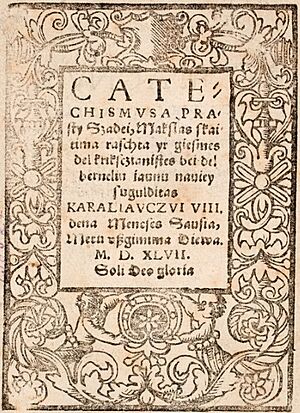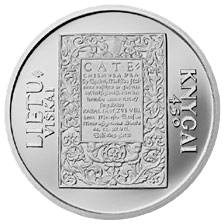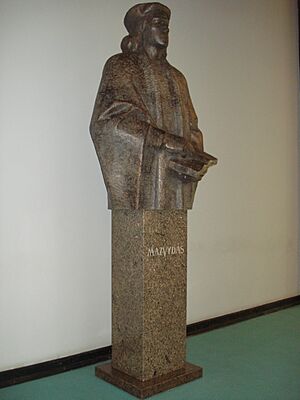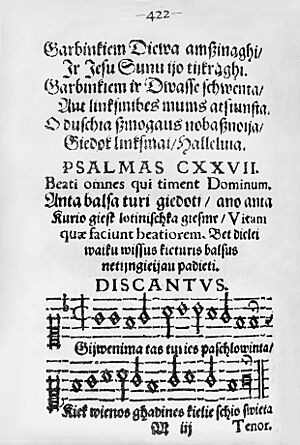Martynas Mažvydas facts for kids

Martynas Mažvydas (born around 1510 – died May 21, 1563) was an important Protestant writer. He is famous for creating the very first printed book in the Lithuanian language.
People knew him by several names, like Martinus Masvidius or M. Mossuids Waytkūnas. No matter the name, he made a huge impact on Lithuanian writing.
Contents
Who Was Martynas Mažvydas?
Martynas Mažvydas was a very productive author in the 1500s. He is considered the founder of Lithuanian literature. He was born in Samogitia, a region in the Grand Duchy of Lithuania. His family was not wealthy.
Mažvydas spent his younger years in Vilnius. There, he worked with other early Lithuanian writers. These included Abraomas Kulvietis and Stanislovas Rapolionis. Mažvydas later helped publish some of their writings.
Why He Moved to Prussia
In Roman Catholic Lithuania, Mažvydas faced problems. This was because he had Protestant beliefs, which were different from the main religion. So, Duke Albrecht of Prussia invited him to come to Königsberg.
Mažvydas started studying at Albertina University in 1546. He earned his bachelor's degree just a year and a half later, in 1548. This quick graduation suggests he had studied somewhere else before. Perhaps he studied in Kraków or at a school in Vilnius.
The First Lithuanian Book
Duke Albrecht wanted to spread the new Protestant faith. He asked for religious texts to be translated into Old Prussian and Lithuanian. In 1547, while still a student, Mažvydas and his team created something amazing.
They put together and published the first printed Lithuanian book. It was called Catechismusa Prasty Szadei, which means "The Simple Words of Catechism". It was printed at the Hans Weinreich printing shop. Only about 300 copies were made.
This book was based on a Polish version of Martin Luther's "Small Catechism". It showed features of both the Samogitian dialect and Aukštaitian language. This first Lithuanian book was printed around the same time as the first books in other nearby languages. For example, Polish books appeared in 1513, and Estonian in 1535.
Life as a Priest and Writer
In 1549, Mažvydas became a priest in Ragainė. This town is now called Neman. In the same year, he wrote and published "The Song of St. Ambrosy". This book included a special dedication written in Lithuanian.
By 1554, Mažvydas became the Archdeacon of Ragainė. This meant he had an important leadership role in the church. He looked after his church members' education. He also helped with farming matters. And he kept working on his Lithuanian writings.
He translated "The Form of Baptism" from German into Lithuanian. It was published in Königsberg in 1559. He also worked on "The Christian Songs" (Gesmes Chriksczoniskas). This large work was printed by his cousin, Baltramiejus Vilentas. It became a base for many other Protestant songbooks in Lithuania Minor.
Mažvydas set the standard for many types of Lithuanian literature. These included a primer (a basic textbook), a catechism, and a songbook with music. He also created prayer books and translated parts of the Holy Writ (the Bible). He even wrote his own original introductions and dedications for his books.
He passed away in Königsberg (now Kaliningrad) when he was about 53 years old.
The Catechism: A Landmark Book

In 1547, Martynas Mažvydas created and published the first printed Lithuanian book. This was the Catechism, also known as The Simple Words of Catechism. This book marked the very beginning of literature and printing in the Lithuanian language. It was printed in Königsberg.
What's Inside the Catechism?
The book starts with a special message in Latin. It is dedicated "To the Grand Duchy of Lithuania". Then, there are two introductions. One is in Latin prose, and the other is in Lithuanian verse.
The rhymed Lithuanian introduction is called The Appeal of The Small Book Itself Unto Lithuanians and Samogitians. This is the first real poem written in Lithuanian. It has a secret message! If you read the first letter of lines 3 to 19 downwards, they spell out "Martinus Masvidius". This confirms that Mažvydas was the author.
The introductions explain why Mažvydas wrote the book. His goals were to teach people and spread knowledge. He also wanted to fight old pagan beliefs. And he aimed to strengthen the Protestant religion in the region.
About 200 copies of the Catechism were printed. Today, only two copies still exist. One is kept at the Vilnius University Library in Lithuania. The other is at the Nicolaus Copernicus University in Toruń Library in Poland.



